Easy Garlic Sourdough Bread Recipe
Garlic sourdough bread recipe is the ideal dish for all garlic lovers. The rich taste of the sourdough pairs superbly with the strong core of roasted garlic, creating a lovely harmony. Each slice has a soft, airy interior, flecked with little nuggets of caramelized garlic. In this article I explain how to make a garlic sourdough bread with a rosemary sourdough bread recipe.
Rosted Garlic Sourdough Recipe and Rosemary Sourdough Bread Recipe:
Garlic sourdough bread and rosemary sourdough bread are so delicious. Slicing into a warm loaf, tender a golden-brown crust and a kind interior, dotted with bits of garlic and spot of green herbs. This bread offers unlimited adjustability. Baking this roasted garlic and rosemary sourdough bread fills your kitchen with warmth and a makes healthy food.
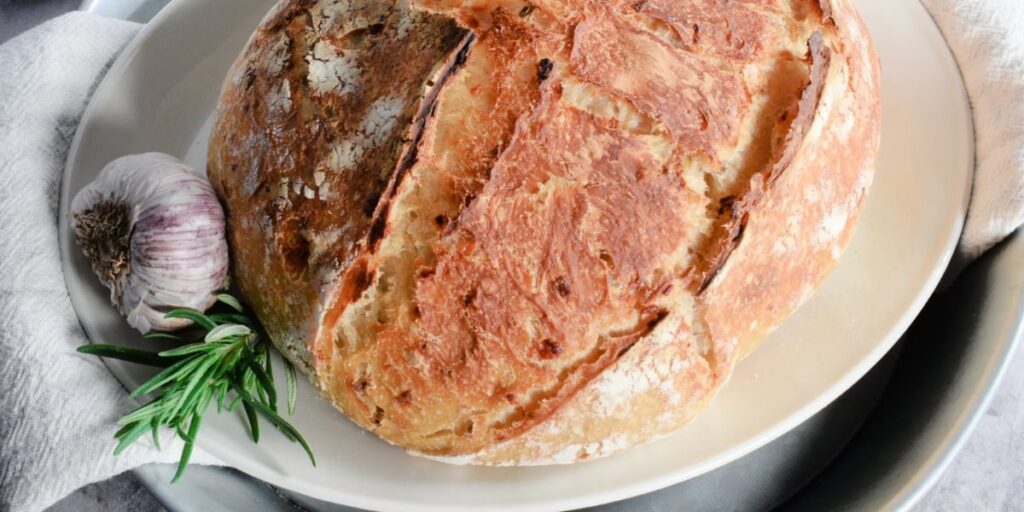
Ingredients:
Active starter:
To bake sourdough garlic bread, feed your own sourdough starter equal ratio water and flour
If you are still unsure, you can use the float test:
Drop the starter into one glass of water, if the starter is floating on the water surface, it means it is ready. If it sinks in water, it means it needs some extra time to boil.
Room temperature water:
The temperature is according to your room temperature. It should not be too cold or too hot.
Bread Flour:
You can use your favourite brand of flour.
Salt:
You can use any salt for an extra mineral.
Fresh Garlic:
A fresh garlic need for a rosemary garlic sourdough bread for its freshness.
Fresh Rosemary:
You need fresh rosemary for the best experience of making rosemary sourdough.
Cheese:
It is not necessary to add cheese to the garlic sourdough bread. If you want to know. You can use cheese in different kinds of cheese like, parmesan cheese and cubed cheese.
Supplies You May Need:
- Kitchen Scale
- Large bowl
- Dough Whisk \ Dutch Whisk
- Dutch Oven
- Proofing basket
- Tea towel
- Sharp knife
- Parchment Paper
- Baking Tray
How to Roast Garlic in the Oven:
Start with preheating your oven to 400 degrees.
Take a head of garlic and peel away the papery layer, reveal the fresh cloves within.
Simply chop off about 1/4 inch from the top of the head, reveal the individual cloves.
A piece of aluminium warp around the garlic. Put 1 tablespoon of extra virgin olive oil on it, and place it into a preheated oven.
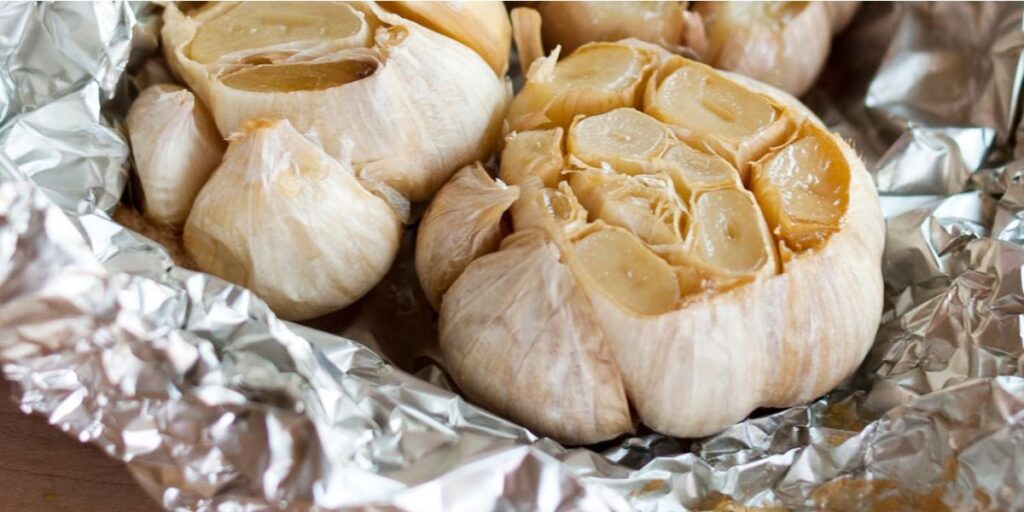
Roast it until the garlic is golden brown.
Before added garlic into the bread cool it down.
Roasted Garlic Substitutions:
When roasted garlic is not on hand, use a garlic powder as a substitute for roasted garlic. While, it lacks the flavour of roasted garlic.
How to Prepare Fresh Rosemary:
For fresh rosemary, pinch the top of the sprig with your fingers and slide them down towards the base, empty off the leaves effortlessly. Rinse it under cold water to remove any dirt or residue. Finely chop the leaves with a sharp knife.

Fresh Rosemary Substitutions:
When fresh rosemary is not available you can use instead of dried rosemary. This stabilizes your flavours.
How to Make Roasted Garlic Sourdough Bread Recipe and Rosemary Sourdough Bread:
Make a dough:
In a sizable mixing bowl, mix 50g of active sourdough starter with 350g of room temperature water, exciting until the mixture looks like a white milky liquid.
When your wet ingredients are ready, slowly add 500g of bread flour and 11g of salt, mix them till the flour is included. On this stage do not be worried, if the dough looks woolly it is meant to be rough and unpurified, not a constant dough ball. Cover the bowl with a damp tea towel to keep alive wetness, let the dough rise to those natural flavors. A minimum resting period of at least 30 minutes can transform your bread remarkably.
Stretch and folds:
The method of stretching and folding transforms your dough from a sticky mass into a beautifully flexible form. Use of the wet fingers, you can stop the dough from holding on to your hands as you gently lift a portion and extend the bread dough above the bowl. As you rotate the bowl clockwise after folding. You can come full circle in just a few minutes. Then cover your dough for at least half hours.
Mix-ins:
Mix-ins elevate any dish to extraordinary, and the right combination can transform your culinary creations. Mix a 1 tablespoon of chopped rosemary, roasted garlic, and 1 cup of cubed cheese.
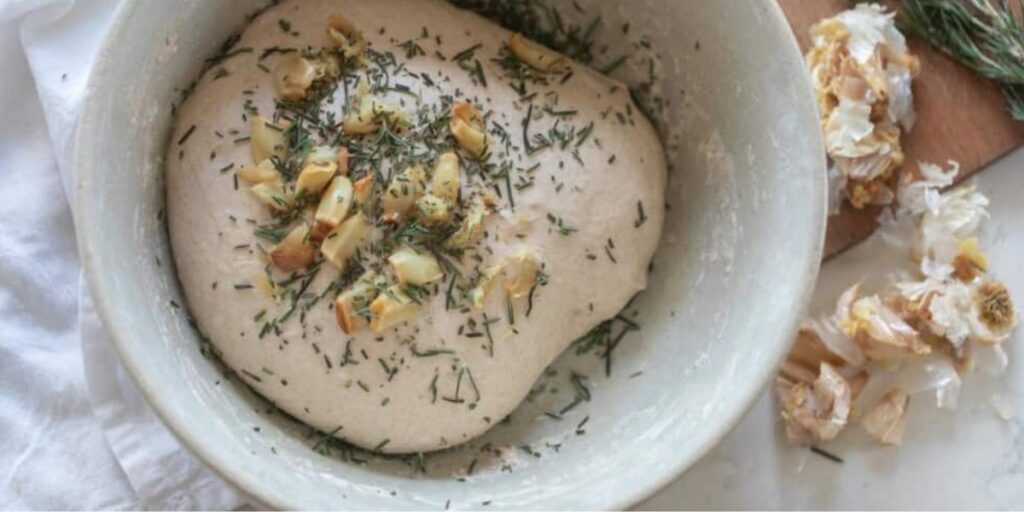
Make a plan to get an extraordinary dough top of you bread sprinkle 1/3 mix-in again, repeat stretch and fold, add again 1/3 of mix-in to the dough, repeat this process at least 3 times. If some cube breaks the dough they will be mixed in the next stretch and folded. As your sourdough starter begins its first rise. At this point your sourdough starter will start.
The next day your dough size will double. With wet fingers, release the dough from the sides of the bowl. Move the dough onto your work surface.
Bulk Fermentation :
Bulk fermentation is a changing phase in bread making that permit the dough to create flavor.
When we complete all the process of stretching and folds, cover it with a damp towel to create a warm, stuffy environment that inspires yeast activity. Leave it in a ferment and let it sit for at least 8 to 10 hours. Your starter makes sourdough bread. As the time passes, the ferment produces gas bubbles that will give your bread its airy form.
Shape :
- On the next day the dough doubles in size.
- Touch your hands using slightly wet fingers to move the dough onto your surface.
- To take a rectangular shape, stretch it. Take 1/3 of the dough and fold it toward the center again 1/3 of the dough fold it towards the bottom repeat this same as and fold the center now.
- Create a ball shape of the dough rolled from right to left side.
- Then leave it for 10 – 12 minutes.
Prepare Banneton :
To prepare your banneton start by cleaning it fairly with flour. Rice flour is especially flavourful for its non-stick effects. This prevents the dough from stick to the basket.
Final Shape :
Next, softly pull the dough towards you while keeping its circular motion. This gentle pull helps create stress on the surface and make sure your loaf will have an attractive structure once baked. Repeat this process gradually and work the dough into a compact circle shape.
This stage the use of a floured proofing basket is crucial. It not only prevents sticking but also helps define the crust as it bakes. Once shaped, cover it with a shower cap or a damp cloth that keeps moisture in while the dough.
SECOND RISE :
During the second last rise we can place a banneton basket in the frigidaire. We can place it at least for 2 hours creating a softer, more expandable dough, that will air more effectively during baking.
Score :
When the second rise is complete remove the banneton basket from the frigidaire.
At this stage transforming a simple loaf into a masterpiece. Cut a piece of parchment paper, this step is crucial for both presentation and practicality. Once you have your parchment ready, then transfer the banneton to your workplace.
By using a sharp knife bakers can score any design onto the surface of their dough. Then transfer it into a dutch oven.
Bake:
When it comes to baking. By placing your dough directly in a cold oven and preheating it to 450 degrees and baking it 1 hour. You allow the bread to rise slowly its flavor.
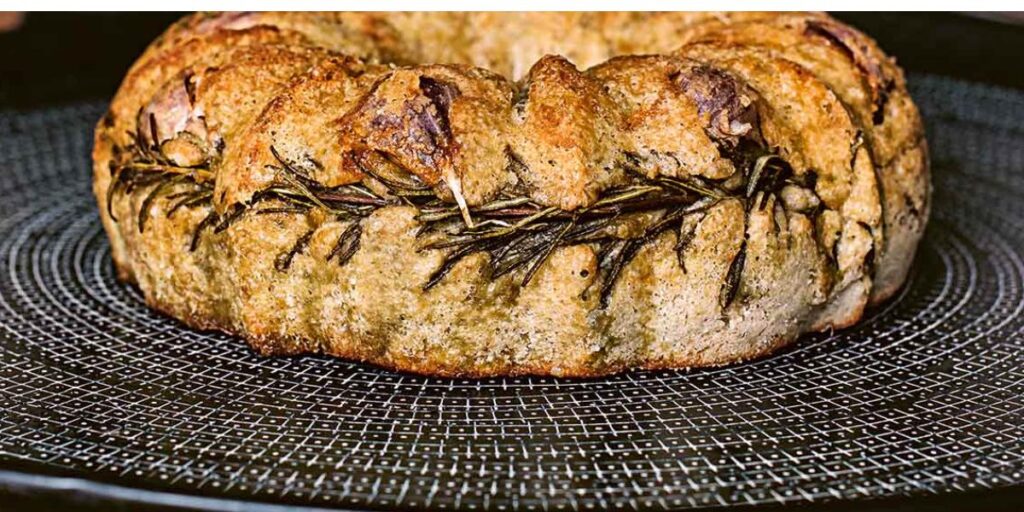
After 1 hour when you remove the dutch oven, put your sourdough bread out of the pot, finally you get the golden crust. Now cool it down for about 1 hour. When it cools down, slide into its pieces and enjoy it.
How to Serve Roasted Garlic Sourdough bread and Rosemary Sourdough Bread:
To serve roasted garlic and rosemary sourdough bread is an art, that lift any feed experience. Slice the warm loaf with a sharp knife permit the crusty exterior to give way to the soft interior. use a selection of cheeses, like creamy cheese which can balance the savory taste of the bread. The mixture of strong flavors and inviting textures turns a simple meal into a unforgettable journey.
How to Store Garlic Sourdough Bread?
For freshness wrap the cooled loaf in plastic wrap or aluminum foil before placing it in the freezer bag. This double layered stop freezer burn and keeps moisture. A crusty exterior and a soft, flavorful interior that carry you back to that first bite of freshly baked garlic sourdough. For better results let the bread melted at room temperature then pop it in a preheated oven for a few minutes to bring round its crusty exterior.
How Should You Store Garlic Sourdough Bread?
Your garlic sourdough will remain delightful 3-4 days. Wrap the loaf in a clean kitchen towel or parchment paper which breeds external humidity.
Conclusion:
This easy rosemary sourdough bread and garlic sourdough bread recipe is simple to follow. These recipes rise the customary sourdough experience making it perfect for any event. This bread is impress to your family and friends. The simplicity of the recipe permit bakers of all skill levels to reach commendable results without feeling submerge.
FAQs.
When to add garlic and rosemary to sourdough?
After your beginning dough has come together and before it starts rising. You can finely chop the garlic and rosemary and smoothly fold them into the dough. This allows their flavors to rise with the bread as it ferments.
Does garlic affect sourdough?
When garlic is held into the dough, it not only fills it with a rich spicy sprite but also interacts with the fermentation process in interesting ways.
What is the secret to making good sourdough bread?
The secret to making good sourdough bread lies in the quality of your starter is key. A strong, active sourdough starter is the heart of your bread. It is also necessary in the balance of time, technique, and ingredients.
Can you make garlic bread with sourdough?
simply slice your sourdough loaf and prepare a garlic butter mixture by combining softened butter, minced garlic, chopped parsley, and a pinch of salt. Spread this mixture between the slices or on top of the cut sides. You can then wrap it in foil and bake it in the oven until it’s warm and toasty.
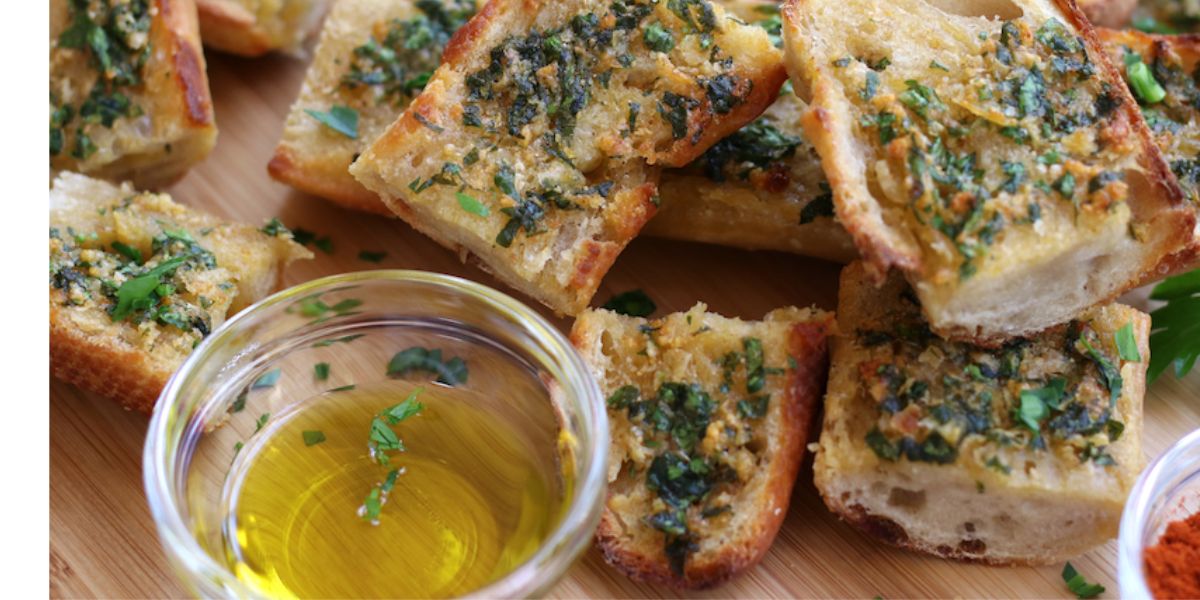
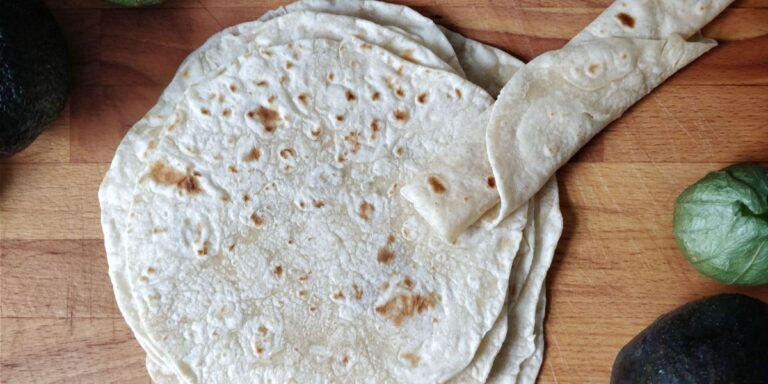





4 Comments